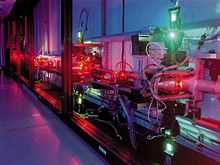Atomic vapor laser isotope separation

Atomic vapor laser isotope separation (AVLIS) is a method by which specially tuned lasers are used to separate isotopes of uranium using selective ionization of hyperfine transitions.[1][2]
In the largest technology transfer in U.S. government history, in 1994 the AVLIS process was transferred to the United States Enrichment Corporation for commercialization. However, on June 9, 1999 after a $100 million investment, USEC cancelled its AVLIS program.
The AVLIS process provides high energy efficiency comparable with gas centrifuges, high separation factor, and low volume of radioactive waste.
AVLIS continues to be developed by some countries and it presents some specific challenges to international monitoring.[3] Iran is now known to have had a secret AVLIS program. However, since it was uncovered in 2003, Iran has claimed to have dismantled it.[4][5]
A similar technology, using molecules instead of atoms, is molecular laser isotope separation (MLIS).
Principle
The absorption lines of 235U and 238U differ slightly due to hyperfine structure; for example, the 238U absorption peak shifts from 502.74 nanometers to 502.73 nm in 235U. AVLIS uses tunable dye lasers, which can be precisely tuned, so that only 235U absorbs the photons and selectively undergoes excitation and then photoionization. The ions are then electrostatically deflected to a collector, while the neutral unwanted uranium-238 passes through.
The AVLIS system consists of a vaporizer and a collector, forming the separation system, and the laser system. The vaporizer produces a stream of pure gaseous uranium.
The laser commonly used is a two-stage tunable pulsed dye laser usually pumped by a copper vapor laser;[6][7][8] the master oscillator is low-power but highly precise, and its power is increased by a dye laser amplifier acting as optical amplifier. Three frequencies ("colors") of lasers are used for full ionization of uranium-235.[9]
See also
- Australian Atomic Energy Commission
- Calutron
- Chemical reaction by isotope selective laser (CRISLA)
- Gas centrifuge
- Gaseous diffusion
- List of laser articles
- Molecular laser isotope separation
- Separation of isotopes by laser excitation (SILEX)
- Nuclear fuel cycle
- Nuclear power
References
- ↑ L. J. Radziemski, R. W. Solarz, and J. A. Paisner (Eds.), Laser Spectroscopy and its Applications (Marcel Dekker, New York, 1987) Chapter 3.
- ↑ Petr A. Bokhan, Vladimir V. Buchanov, Nikolai V. Fateev, Mikhail M. Kalugin, Mishik A. Kazaryan, Alexander M. Prokhorov, Dmitrij E. Zakrevskii: Laser Isotope Separation in Atomic Vapor. Wiley-VCH, Berlin, August 2006, ISBN 3-527-40621-2
- ↑ Ferguson, Charles D.; Boureston, Jack (March–April 2005). "Laser Enrichment: Separation Anxiety". Council on Foreign Relations. Retrieved 2010-11-22.
- ↑ Ferguson, Charles D.; Boureston, Jack (June 17, 2004). "Focusing on Iran's Laser Enrichment Program" (PDF). FirstWatch International. Retrieved 2010-11-22.
- ↑ Paul Rogers (March 2006). "Iran's Nuclear Activities". Oxford Research Group. Retrieved 2010-11-22.
- ↑ F. J. Duarte and L.W. Hillman (Eds.), Dye Laser Principles (Academic, New York, 1990) Chapter 9.
- ↑ C. E. Webb, High-power dye lasers pumped by copper vapor lasers, in High Power Dye Lasers, F. J. Duarte (Ed.) (Springer, Berlin, 1991) Chapter 5.
- ↑ F. J. Duarte, Tunable lasers for atomic vapor laser isotope separation: the Australian contribution, Australian Physics 47(2), 38-40 (2010).
- ↑ ""Annex 3": List of Items to Be Reported to IAEA". Iraqwatch.org. Retrieved 2010-11-22.
External links
- USEC News Release Cancelling AVLIS
- Report on Iranian AVLIS program
- Oxford Research Group report on Iran's nuclear activities.
- Laser isotope separation uranium enrichment
- Overview of Uranium Atomic Vapor Laser Isotope Separation R.M. Feinburg and R.S. Hargrove. UCRL-ID-114671 August 1993.
- Laser Isotope Separation page at LLNL